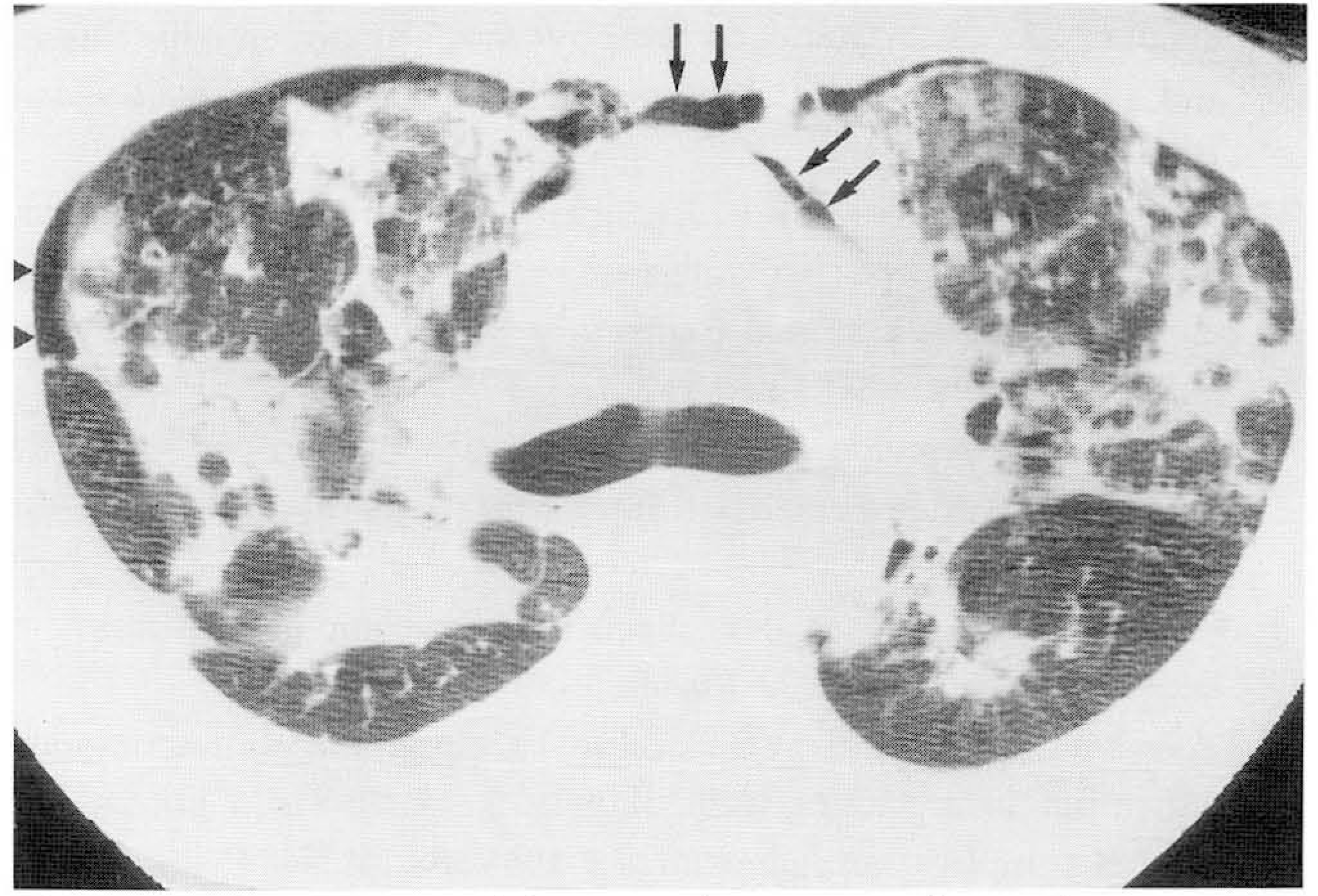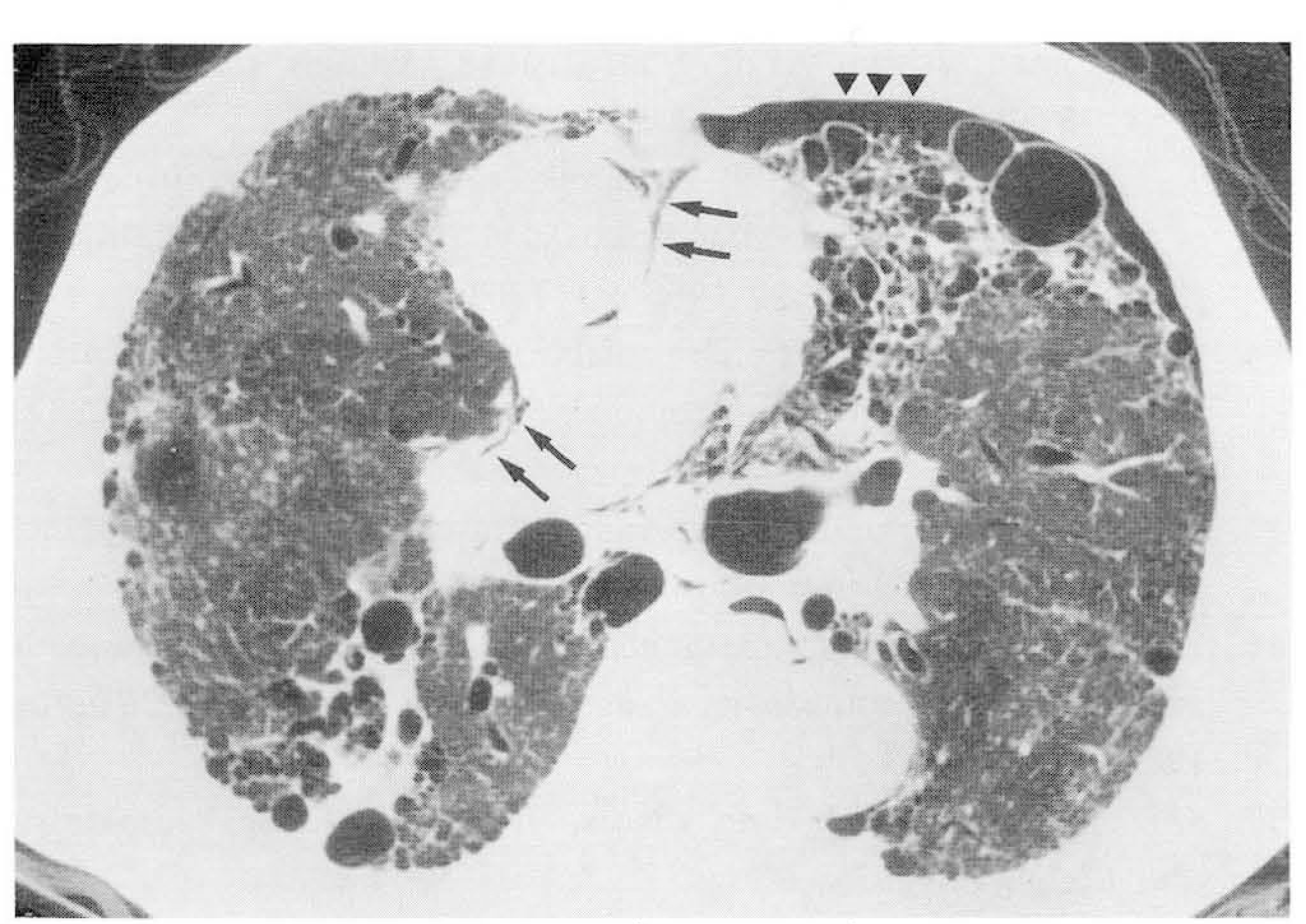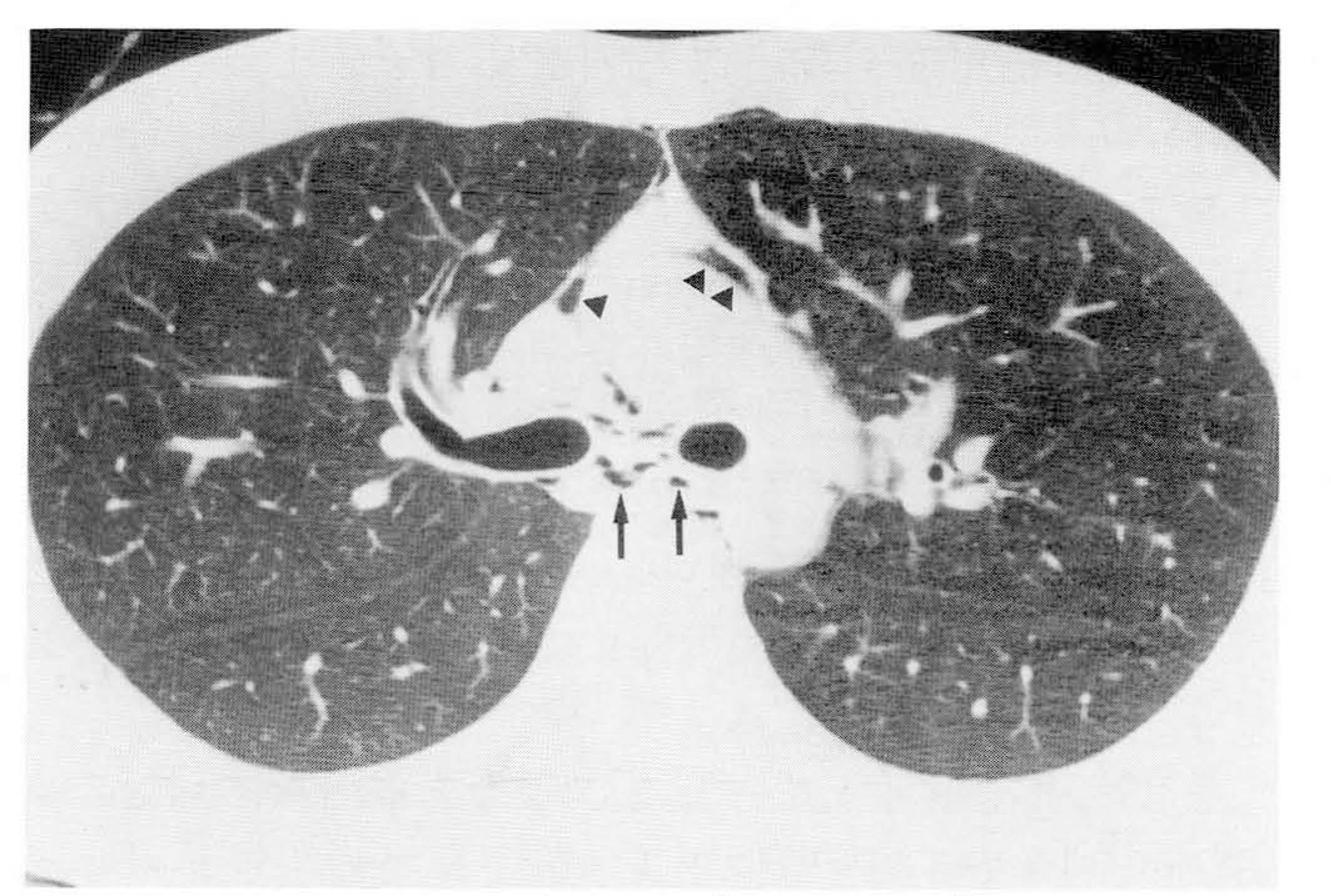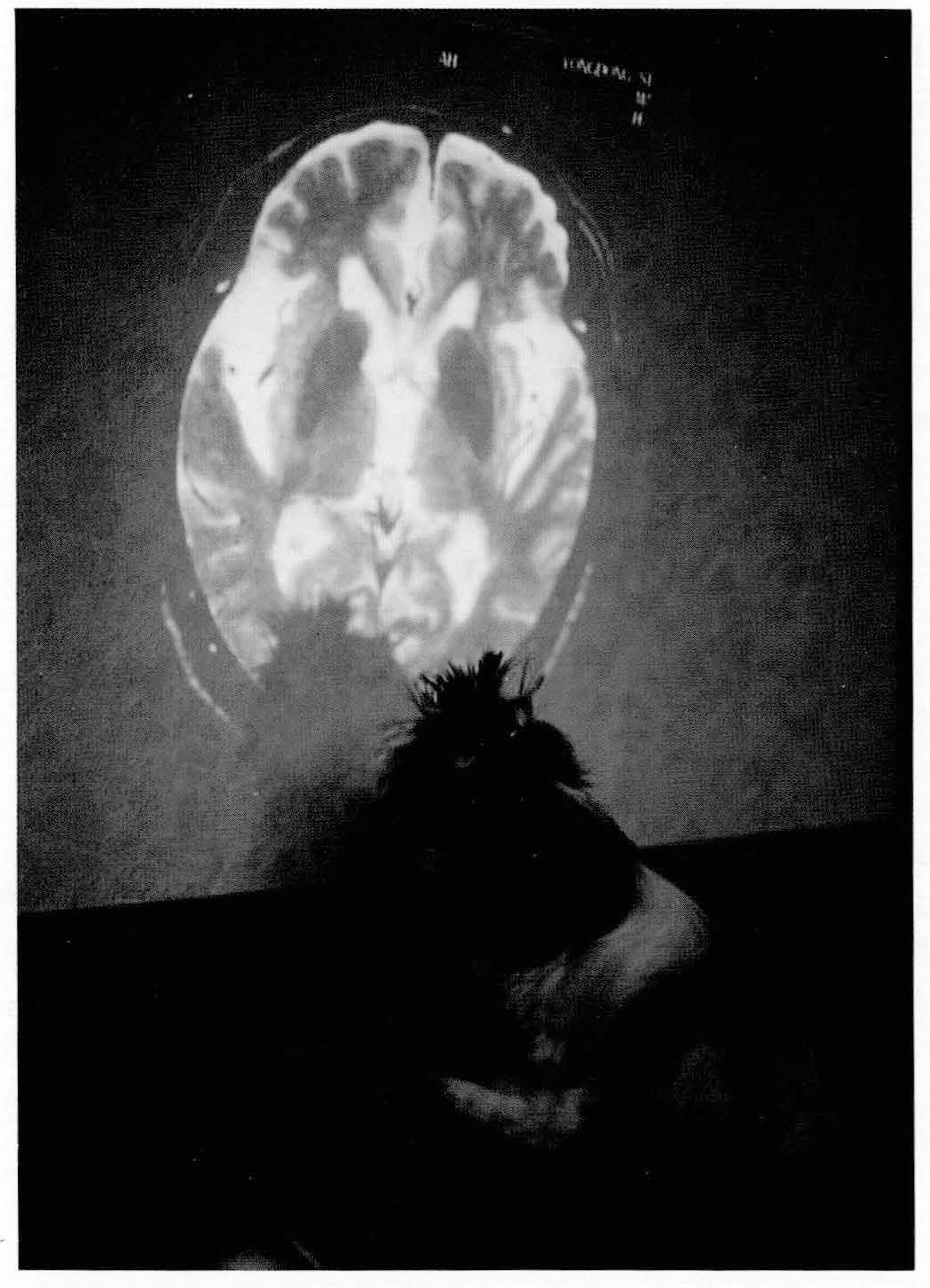Abstract
Purpose:
To tabulate underlying disease and to assess the clinical significance of CT-diagnosed spontaneous pneumomediastinum.
Materials and Methods:
We retrospectively reviewed CT scans and medical records of 11 consecutive patients with spontaneous pneumomediastinum, and analyzed their clinical history and course, and in five cases, pulmonary function. CT scans of 126 patients with idiopathic pulmonary fibrosis (IPF) collected while the 11 consecutive patients were being treated were analyzed for the prevalence of pneumomediastinum. We analyzed CT findings with respect to the amount and distribution of air in the mediastinum, and the presence or absence of air outside the mediastinum.
Results:
In the 11 patients, underlying diseases were IPF (n=4), bronchiolitis obliterans organizing pneumonia (BOOP)(n=2), bronchiectasis (n=2), tuberculous tracheal stenosis (n=l), and pulmonary tuberculosis with bullous emphysema (n=l); there was one without associated disease. Of the 126 patients with IPF, four (3.2%) showea spontaneous pneumomediastinum. All ten with underlying diseases had severe dyspnea. In five patients, a pulmonary function test showed marked impairment. Two of four patients with IPF and both with BOOP died within 2 months of CT scanning, whereas the remaining six showed clinical improvement. The detection rate of pneumomediastinum on plain chest radiograph was 82% (9/ll). CT showed that mediastinal air was most frequently found in the retrosternal space. There were four cases of pneumothorax and two of subcutaneous emphysema.
Go to : 
REFERENCES
1.Holmes KD., McGuirt WF. Spontaneous pneumomediastinum: evaluation and treatment. J Fam Pract. 1990. 31:422–499.
2.Abolnik I., Lossos IS., Breuer R. Spontaneous pneumomediastinum, a report of 25 cases. Chest. 1991. 100:93–95.
3.Reeder SR. Subcutaneous emphysema, pneumomediastinum, and pneumothorax in labor and delivery. Am J Obstet Gynecol. 1986. 154:487–489.

4.Man ο JC., Terra-Filho J., Silva CA. Pneumomediastinum, pneumothorax and subcutaneous emphysema following the measurement of maximal expiratory pressure in a normal subject. Chest. 1990. 98:1530–1532.

5.de la Fuente Aguado J., Roman F., Hernaez JM., Provencio M., de Letona JM. Pneumomediastinum after belching. Lancet. 1990. 336:1390.
6.Cicuttini FM., Fraser KJ. Recurrent pneumomediastinum in adult dermatomyositis. J Rheum. 1989. 16:384–386.
7.Weathers LS., Brooks WG., Declue TJ. Spontaneous pneumomediastinum in a patient with diabetic ketoacidosis: a potentially hidden complication. South Med J. 1995. 88:483–484.
8.O'Connor I., Thomas GO. Spontaneous pneumomediastinum in a patient with fibrosing alveolitis. Resp Med. 1993. 87:313–314.
10.Amorosa JK., Schaffer RM., Smith PR., Cohen JR., Robinson R. Sarcoidosis and mediastinal emphysema. Radiology. 1978. 127:314.

11.Munsell WP. Pneumomediastinum. A report of 28 cases and review of the literature. JAMA. 1967. 202:689–693.

12.Yellin A., Gapany-Gapanavicius M., Leiberman Y. Spontaneous pneumomediastinum: is it a rare cause of chest pain? Thorax. 1983. 38:383–385.

13.Shennib HF., Barkun AN., Blundell PE. Surgical decompression of a tension pneumomediastinum, a ventilatory complication of status asthmaticus. Chest. 1988. 93:1301–1302.
14.Beyers JA., Melonas CF. The visible wall of a main bronchus: a new radiologic sign of pneumomediastinum. Br J Radiol. 1987. 60:877–879.
15.Fujiwara T. Pneumomediastinum in pulmonary fibrosis, detection by computed tomography. Chest. 1993. 104:44–46.
16.Yellin A., Gapany-Gapanavicius M., Lieberman Y. Spontaneous pneumomediastinum: is it a rare cause of chest pain? Thorax. 1983. 38:383–385.

18.Macklin MT., Macklin CC. Malignant interstitial emphysema of the lungs and mediastinum as an important occult complication in many respiratory disease and other conditions: an interpretation of the clinical literature in the light of laboratory experiment. Medicine. 1944. 23:281–358.
Go to : 
 | Fig. 1.A 38-year-old man (patient 5) with pneumomediastinum and pathologically proven bronchiolitis obliterans organizing pneumonia. High-resolution CT shows multiple air bubbles in retrosternal, preaortic area (arrow). Dense and multiple patch consolidations and associated pneumothorax (arrowhead) are also seen. The patient was expired 40 days after CT scan. |
 | Fig. 2.A 62-year-old man (patient 2) with pneumomediastinum and idiopathic pulmonary fibrosis. High-resolution CT shows multiple linear air densities surrounding the great vessels in mediastinum (arrow) and associated pneumothorax (arrowhead) in left hemithorax. Honeycomb appearance are well visualized in the peripheral portion of the lung. PFT revealed severe restrictive and obstructive pattern. The patient showed stationary outcome after treatment. |
 | Fig. 3.An 18-year-old man (patient 11) without any associated respiratory disease: multiple air pocket in subcarinal (arrow) and preaortic area (arrowhead) are well documented. Note the normal lung parenchyma. The patient had history of playing basketball for 2 hours just before symptom onset. |
Table 1.
Distribution of Air on CT




 PDF
PDF ePub
ePub Citation
Citation Print
Print



 XML Download
XML Download